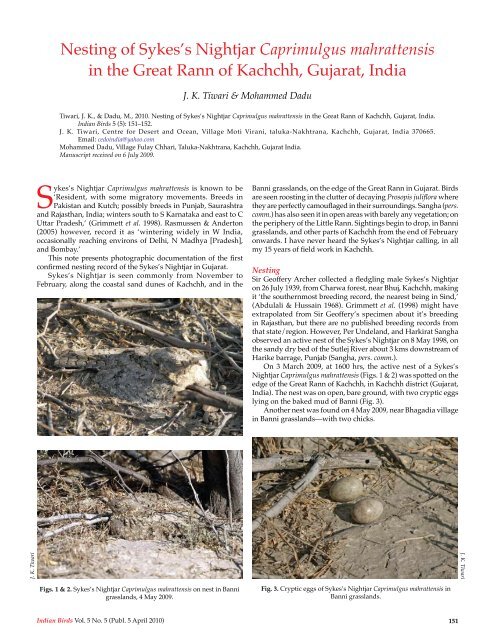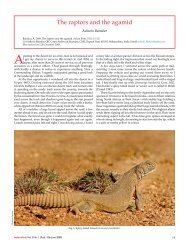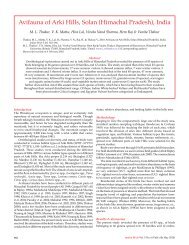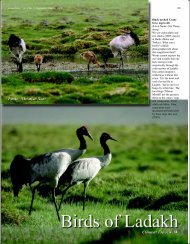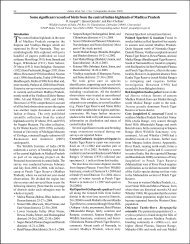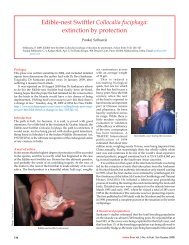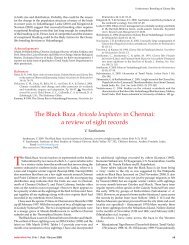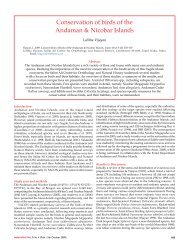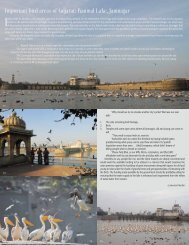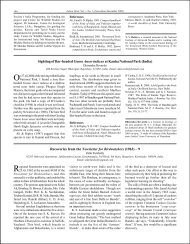Nesting of Sykes's Nightjar Caprimulgus mahrattensis ... - Indian Birds
Nesting of Sykes's Nightjar Caprimulgus mahrattensis ... - Indian Birds
Nesting of Sykes's Nightjar Caprimulgus mahrattensis ... - Indian Birds
- No tags were found...
You also want an ePaper? Increase the reach of your titles
YUMPU automatically turns print PDFs into web optimized ePapers that Google loves.
<strong>Nesting</strong> <strong>of</strong> Sykes’s <strong>Nightjar</strong> <strong>Caprimulgus</strong> <strong>mahrattensis</strong>in the Great Rann <strong>of</strong> Kachchh, Gujarat, IndiaJ. K. Tiwari & Mohammed DaduTiwari, J. K., & Dadu, M., 2010. <strong>Nesting</strong> <strong>of</strong> Sykes’s <strong>Nightjar</strong> <strong>Caprimulgus</strong> <strong>mahrattensis</strong> in the Great Rann <strong>of</strong> Kachchh, Gujarat, India.<strong>Indian</strong> <strong>Birds</strong> 5 (5): 151–152.J. K. Tiwari, Centre for Desert and Ocean, Village Moti Virani, taluka-Nakhtrana, Kachchh, Gujarat, India 370665.Email: cedoindia@yahoo.comMohammed Dadu, Village Fulay Chhari, Taluka-Nakhtrana, Kachchh, Gujarat India.Manuscript received on 6 July 2009.Sykes’s <strong>Nightjar</strong> <strong>Caprimulgus</strong> <strong>mahrattensis</strong> is known to be‘Resident, with some migratory movements. Breeds inPakistan and Kutch; possibly breeds in Punjab, Saurashtraand Rajasthan, India; winters south to S Karnataka and east to CUttar Pradesh,’ (Grimmett et al. 1998). Rasmussen & Anderton(2005) however, record it as ‘wintering widely in W India,occasionally reaching environs <strong>of</strong> Delhi, N Madhya [Pradesh],and Bombay.’This note presents photographic documentation <strong>of</strong> the firstconfirmed nesting record <strong>of</strong> the Sykes’s <strong>Nightjar</strong> in Gujarat.Sykes’s <strong>Nightjar</strong> is seen commonly from November toFebruary, along the coastal sand dunes <strong>of</strong> Kachchh, and in theBanni grasslands, on the edge <strong>of</strong> the Great Rann in Gujarat. <strong>Birds</strong>are seen roosting in the clutter <strong>of</strong> decaying Prosopis juliflora wherethey are perfectly camouflaged in their surroundings. Sangha (pers.comm.) has also seen it in open areas with barely any vegetation; onthe periphery <strong>of</strong> the Little Rann. Sightings begin to drop, in Bannigrasslands, and other parts <strong>of</strong> Kachchh from the end <strong>of</strong> Februaryonwards. I have never heard the Sykes’s <strong>Nightjar</strong> calling, in allmy 15 years <strong>of</strong> field work in Kachchh.<strong>Nesting</strong>Sir Ge<strong>of</strong>fery Archer collected a fledgling male Sykes’s <strong>Nightjar</strong>on 26 July 1939, from Charwa forest, near Bhuj, Kachchh, makingit ‘the southernmost breeding record, the nearest being in Sind,’(Abdulali & Hussain 1968). Grimmett et al. (1998) might haveextrapolated from Sir Ge<strong>of</strong>fery’s specimen about it’s breedingin Rajasthan, but there are no published breeding records fromthat state/region. However, Per Undeland, and Harkirat Sanghaobserved an active nest <strong>of</strong> the Sykes’s <strong>Nightjar</strong> on 8 May 1998, onthe sandy dry bed <strong>of</strong> the Sutlej River about 3 kms downstream <strong>of</strong>Harike barrage, Punjab (Sangha, pers. comm.).On 3 March 2009, at 1600 hrs, the active nest <strong>of</strong> a Sykes’s<strong>Nightjar</strong> <strong>Caprimulgus</strong> <strong>mahrattensis</strong> (Figs. 1 & 2) was spotted on theedge <strong>of</strong> the Great Rann <strong>of</strong> Kachchh, in Kachchh district (Gujarat,India). The nest was on open, bare ground, with two cryptic eggslying on the baked mud <strong>of</strong> Banni (Fig. 3).Another nest was found on 4 May 2009, near Bhagadia villagein Banni grasslands—with two chicks.J. K. TiwariJ. K. TiwariFigs. 1 & 2. Sykes’s <strong>Nightjar</strong> <strong>Caprimulgus</strong> <strong>mahrattensis</strong> on nest in Bannigrasslands, 4 May 2009.Fig. 3. Cryptic eggs <strong>of</strong> Sykes’s <strong>Nightjar</strong> <strong>Caprimulgus</strong> <strong>mahrattensis</strong> inBanni grasslands.<strong>Indian</strong> <strong>Birds</strong> Vol. 5 No. 5 (Publ. 5 April 2010) 151
Tiwari & Dadu: Sykes’s <strong>Nightjar</strong>Various ornithologists have found eggs <strong>of</strong> Sykes’s <strong>Nightjar</strong> inMarch–April in Sind (Pakistan), in habitat similar to that in theGreat Rann <strong>of</strong> Kachchh (Roberts 1991).Since the breeding <strong>of</strong> Sykes’s <strong>Nightjar</strong> is semi-colonial (Roberts1991), birdwatchers in north-western India should be alert duringMarch–May for sight records, calls, display flights, and hopefully,more nesting records.J. K. TiwariSykes’s <strong>Nightjar</strong> <strong>Caprimulgus</strong> <strong>mahrattensis</strong> chicks in nest in Bannigrasslands, 4 May 2009.ReferencesAbdulali, H. & Hussain, S. A. 1971. Extension <strong>of</strong> the breeding range <strong>of</strong>Sykes’s <strong>Nightjar</strong> (<strong>Caprimulgus</strong> <strong>mahrattensis</strong> Sykes) in <strong>Indian</strong> limits. J.Bombay Nat. Hist. Soc. 68 (2): 452.Grimmett, R., Inskipp, C., & Inskipp, T., 1998. <strong>Birds</strong> <strong>of</strong> the <strong>Indian</strong> Subcontinent.1st ed. London: Christopher Helm, A & C Black.Rasmussen, P. C., & Anderton, J. C., 2005. <strong>Birds</strong> <strong>of</strong> South Asia: the Ripley guide:attributes and status. Vol. 2. 1st ed. Washington, D.C. and Barcelona:Smithsonian Institution and Lynx Edicions.Roberts, T. J., 1991. The <strong>Birds</strong> <strong>of</strong> Pakistan: regional studies and non-passeriformes.Vol. 1. 1st ed. Karachi: Oxford University Press.A study on the habits <strong>of</strong>Oriental Magpie-Robin Copsychus saularisR. SreekarSreekar, R. 2010. A study on the habits <strong>of</strong> Oriental Magpie-Robin Copsychus saularis. <strong>Indian</strong> <strong>Birds</strong> 5 (5): 152–153.R. Sreekar, Flat No. 306, Shanthi Soudha Apts., Erramanzil colony, Hyderabad 500 082, India. Email: sreekar1988@gmail.comManuscript received on 13 April 2009.IntroductionOriental Magpie-Robin Copsychus saularis is one <strong>of</strong> the mostfamiliar birds in southern India, and yet there is very littlementioned about its habits in literature (Bonnell 1934). Robinsmostly feed on invertebrates and there are records <strong>of</strong> them feedingon geckos (Sumithran 1982; Saxena 1998). Here I present results <strong>of</strong>a study conducted in the months <strong>of</strong> June–July 2008 on habitat use,food habits, and song <strong>of</strong> Oriental Magpie-Robins in the property<strong>of</strong> the Madras Crocodile Bank Trust / Centre for Herpetology,Mammalapuram, Tamil Nadu, India.Study areaMadras Crocodile Bank Trust (12º44’35’’N 80º14’23’’E; MCBT)forms an expanse <strong>of</strong> about 3.4 ha <strong>of</strong> semi-wilderness along thecoast <strong>of</strong> the Bay <strong>of</strong> Bengal in the state <strong>of</strong> Tamil Nadu (southernIndia). The characteristic feature <strong>of</strong> MCBT is its overlap betweenthe habitat, which is woodland and wetland. 62 species <strong>of</strong> birdsare recorded from MCBT, and it is also home to 23 species <strong>of</strong> birds,which reside, and breed within the park limits. Little CormorantPhalacrocorax niger, Little Egret Egretta garzetta, Median EgretMesophoyx intermedia, and Black-Crowned Night Heron Nycticoraxnycticorax breed in large numbers on the trees in MCBT.Fig 1. Map showing the territory <strong>of</strong> a Magpie Robin pair in MadrasCrocodile Bank. Rectangle enclosed in a black Line=territory; Reddot=nesting site; Yellow dots=common feeding sites; Blue dot=commonsinging site. [Source <strong>of</strong> map: Google Earth.]MethodsThe robin study in MCBT was carried out regularly, on a dailybasis, during the study period. Spot-mapping technique (Ralph etal. 1993) was employed to study the birds. All observations weremade using a pair <strong>of</strong> 10x50 binoculars. Graphs were generatedusing MS Excel s<strong>of</strong>tware.Home rangeHome range is calculated by circling the sightings <strong>of</strong> the birdsaround the distance, and the area is calculated by drawing152<strong>Indian</strong> <strong>Birds</strong> Vol. 5 No. 5 (Publ. 5 April 2010)


